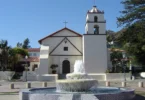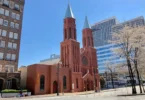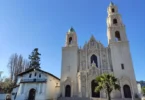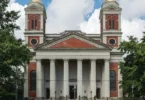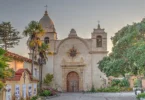
Introduction
The Basilica of the Royal Marian Shrine of Our Lady of Candelaria is a Roman Catholic minor basilica, the first Marian shrine of the Canary Islands, located in the municipality and city of Candelaria on the island of Tenerife (Canary Islands, Spain). It is located some 20 km (12 miles) south of the island’s capital, Santa Cruz de Tenerife.
The basilica is dedicated to the Virgin of Candelaria (Patron of the Canary Islands). Designed by architect José Enrique Marrero Regalado, it is listed as a Site of cultural interest by the Government of the Canary Islands.
The Virgin of Candelaria is a Black Madonna.
History of Basilica of Candelaria, Spain

In 1390, Candelaria was a solitary place frequented by guanches herders of the menceyato de Güímar (pre-Hispanic kingdom). One evening, two natives leading their cattle, saw some goats refusing to come to the mouth of the ravine; they sent forward one of them thinking that there were people who wanted to steal them and they found, on a rock, the statue of the Virgin of Candelaria (later declared principal patron of the Canary Islands).
The statue was found in a beach near to Candelaria. It was initially taken to the cave of Chinguaro, which was the palace of the king (mencey) of Güímar. Later the Guanches moved her to the cave of Achbinico in Candelaria, and from then on it was venerated there. At first the Guanches identified it with their goddess Chaxiraxi (the mother of the gods), but later the Christian conquerors identified it as the statue of the Virgin Mary. Shortly after, a chapel was built.
This cave was also used as a cemetery for Christian devotees of the Virgin. In 1596, king Philip III was declared protector of the Virgin of Candelaria. After ascending the throne, the Spanish monarch gave the title of “Royal” to the sanctuary of the Candelaria. Therefore, it is also the first sanctuary in the Canary Islands to have received that title.
Later, the present basilica was built over an old church that was destroyed by fire in 1789. However, the actual construction of the temple was postponed several times for various reasons: the economic crisis of 1931 following the proclamation of the Second Republic and later by World War II and the Spanish Civil War. Finally, the bishop of Tenerife, Domingo Pérez Cáceres promoted the construction, commissioning the architect Jose Enrique Marrero Regalado.
The new sanctuary would be a neo-Canarian eclectic mix of all styles that have occurred in the Canary Islands. Several donations came from all the islands, the basilica would take almost a decade to finish. Finally, on February 1, 1959, the basilica was consecrated in a large religious ceremony. Nowadays Candelaria is the main Catholic centre of pilgrimage in the Canary Islands and one of the main ones in Spain; the basilica receives more than 2.5 million visitors annually. The Basilica of Our Lady of Candelaria can host up to 5,000 people.
Among the most significant figures who have visited the basilica include heads of state or government, as well as the most prominent figures of the Church, military, politics, sports, art, etc. Among them are the former kings of Spain, Juan Carlos I de Borbón and Sofia of Greece, who visited while still being princes, and later as kings, in 1977.
The church holds the title and dignity of a minor basilica, bestowed upon it by Pope Benedict XVI on 24 January 2011. That title was officially celebrated on 2 February of that year, coinciding with the feast of Candlemas.
Currently, this Marian shrine attracts not only pilgrims and devout Catholics, but also followers of other religions. Among the latter are some people from the Hindu community in Tenerife, who donated some robes for the Virgin’s statue. Every year in May is celebrated in the Plaza de la Patrona de Canarias, the Festival Intercultural India – Canarias (Intercultural Festival India – Canary Islands), which aims to present the Hindu customs through gastronomy and folklore.
Architecture of Basilica of Candelaria, Spain

- Architectural Style: Neoclassical Architecture
- Architect: José Enrique Marrero Regalado
The basilica is consecrated to the Virgin of Candelaria, Patron General of the Canary Archipelago. This building was declared an Asset of Cultural Interest and in 2011, the temple was elevated to the dignity of Minor Basilica by Pope Benedict XVI. Its construction in 1959, involved the island society, which did not hesitate to make donations to cover its costs. Bishop Domingo Pérez Cáceres promoted the work and commissioned it from the Canarian architect Enrique Marrero Regalado.
As a result, today we see a modern building, in a neo-Canarian style and an eclectic mix of the different construction styles that have occurred in the Canary Islands. The capitals of the central nave are of the Doric order and the polychromy of the ceiling alludes, in a symbolic way, to the tones of the classical dress of the Virgin. The main altar is decorated with an immense mural by the painter José Aguiar and houses the current Image of Candelaria, the work of the Canarian sculptor Fernando Estévez del Sacramento, who was commissioned with this delicate work of art, which, after the flood of 1826, left the islanders without the primitive image found by the Guanches.
Today we see the Virgin on a wooden throne with golden plant motifs and surrounded by angels on the sides, the Virgin has a quarter crescent or half moon at her feet, which alludes to Revelation 12: “a sign appeared in heaven big, clothed woman of sun, with the moon at the feet”. Also inside the basilica there is an allusion, through the paintings of José Aguiar, to two illustrious Canarian characters. Above the access door to the dressing room, a scene with Father José de Anchieta, a Jesuit missionary and Blessed from the Canary Islands in Brazil, is represented. And at the access door to the sacristy, a scene with Santo Hermano Pedro, reminds us of the Franciscan missionary and religious, who was canonized in Guatemala City in 2002 by Pope Benedict XVI.
Also worth mentioning are the two paintings that are on both sides of the main entrance, works by the painter from Guía de Isora Manuel Martín González and that represent the places where the Holy image appeared, as well as the murals of access to the sail boat that are works of the candle stick painters Juan Ruano and Dimas Coello; or the mural in the Santísimo chapel that represents the Agitation of the Angels and the Holy Supper, a work completed by the painter Waldo Aguiar.
Without a doubt, the Basilica of Candelaria is one of those meeting points for all Canarians. One of the main pilgrimage destinations in the islands and a sanctuary consecrated to the Virgin of Candelaria, Patron General of the Canary Archipelago. Its construction is modern since the first, inaugurated in 1672, was destroyed after a terrible fire in 1789. After several reconstruction attempts, the new sanctuary that we see today became a reality on February 1, 1959.
The exterior of the building is modern, regionalist in style and with an eclectic mix of all the styles that have occurred in the Canary Islands, from Gothic to our days. With a capacity for about 5,000 people, its interior stands out for its decoration and the main altar, where the Virgin of Candelaria presides, a carving made by the sculptor Fernando Estévez. The murals that adorn it are the work of the painter José Aguiar, a good example of his expressionist style. Although to enjoy one of his best works, it will be necessary to visit the Chapel of the Virgin, which will welcome us with the mural of the “Multiplication of Loaves and Fishes”.
Interior of the Basilica
Another feature of the basilica are the mural paintings that are mostly found on the altar. These paintings usually represent angels and other canarian saints who were devotees of the Virgin of Candelaria. On one side of the main altar is the flag of the Vatican City, referring to the close relationship of the sanctuary with the Pope because of its status as a minor basilica. Above the altar is the statue of the Virgin.
The Camarín de la Virgen de Candelaria, a room just behind the altar, is the location of the wooden statue of the Virgin of Candelaria.
The Capilla del Sagrario is located next to the sacristy, features a mural depicting the Last Supper of Jesus with his apostles, by José Aguiar. Also found in the chapel windows with scenes from the apparition of the Virgin to the Guanches.
The Capilla del Cristo de la Reconciliación was blessed on 19th April 1996. It features an image of the crucified Christ made by artist Ricardo Rivera Martínez in 1936. The Chapel of the Holy Christ of Reconciliation is the penitential chapel of the basilica, dedicated to the confessions. This image of Jesus Christ is inspired by the Shroud of Turin primarily by the position of the nails in his hands.
The Sala de las Velas next to the main entrance to the basilica. Takes its name from offerings of candles and flowers placed inside the faithful. Here is the painting of the Canonical Coronation of the Virgin of Candelaria. In the room there are phrases that tell the story of the Virgin and her temple.
Virgin of Candelaria (Our Lady of Candelaria)

The Virgin of Candelaria or Our Lady of Candle popularly called La Morenita, celebrates the Virgin Mary on the island of Tenerife, one of the Canary Islands (Spain). The centre of worship is located in the city of Candelaria in Tenerife. She is depicted as a Black Madonna.
The “Royal Basilica Marian Shrine of Our Lady of Candelaria” is considered the main church dedicated to the Virgin Mary in the Canary Islands and she is the patron saint of the Canary Islands. Her feast is celebrated on February 2 and August 15, the patronal feast of the Canary Islands.
She is also the patroness of the Western Visayas region enshrined in Jaro Cathedral or the National Shrine of Our Lady of the Candles under the Archdiocese of Jaro in the Philippines, and Tatala, one of the barangays in Binangonan, Rizal, which celebrates her feast day every February 2. The Municipality of Silang in the province of Cavite, Philippines, also celebrates her feast day from February 1 to 3, with February 2 the main feast day.
Legend and Appearance

According to a legend recorded by Alonso de Espinosa in 1594, a statue of the Virgin Mary, bearing a child in one hand and a green candle in the other (hence “Candelaria”), was discovered on the beach of Chimisay by two Guanche goatherds in 1392. This was before the Castilian conquest of the island of Tenerife (the island was not fully conquered until 1496).
One of the shepherds tried to throw a stone at the statue, but his arm became paralysed; the other tried to stab the statue with a knife but ended up stabbing himself. The statue was taken by the local guanche mencey to the cueva de Chinguaro.
Later, Antón, a Guanche who had been enslaved and converted to Christianity by the Castilians, returned to Tenerife and recognized the statue as that of the Virgin Mary. He told the mencey of his conversion and the statue was thus venerated by the Guanches, who moved it to the cave of Achbinico (also known as San Blas – “Saint Blaise”). However, the statue was stolen and taken away to Lanzarote. It was later returned to Tenerife after various events, including an outbreak of the plague, occurred on Lanzarote.
At first, the autochthons identified the statue with their goddess Chaxiraxi (the mother of the gods), but later the Christian conquerors imposed the idea that the statue was that of the Virgin Mary.
After the appearance of the Virgin and its iconographic identification with this biblical event, the festival began to be celebrated with a Marian character in the year 1497, when the conqueror Alonso Fernández de Lugo, celebrated the first Candlemas festival dedicated especially to the Virgin Mary, coinciding with the Feast of Purification, on February 2. Before the conquest of Tenerife, the Guanche aborigines celebrated a festivity around the image of the Virgin during the Beñesmen festival in the month of August.
The original statue was a medieval gothic sculpture with dark colour and clothing similar to that of the Virgin of Lluch (patron saint of Mallorca) and the Virgin of Montserrat (patron saint of Catalonia).
Veneration

The first mass was celebrated at Achbinico on February 2, 1497, and the Adelantado Alonso Fernández de Lugo ordered the construction of a hermitage there, but it was not built until 1526, during the rule of Pedro Fernández de Lugo. This was the site of the Basilica of Our Lady of Candelaria. The basilica was destroyed by fire and rebuilt in the 19th century. The statue itself was lost when a tsunami carried it out to sea in 1826; the present statue is a copy by Fernando Estévez. The statue of the Virgin is dressed in rich robes of different colors and jewels.
She was declared patroness of the Canary Islands in 1559, by Clement VIII (and principal patroness in 1867 by Pope Pius IX). The Virgin of Candelaria is widely petitioned to pray for the protection against epidemics, plagues, droughts and volcanic eruptions of Mount Teide and other volcanoes, in a manner similar to the invocation of St. Januarius of Naples to pray for the end of the eruptions of Vesuvius and of St. Agatha of Catania against eruptions of Mount Etna in Sicily.
Between October 1964 and January 1965, the Diocese of Tenerife conducted the largest pilgrimage in the history of the Canary Islands. This time, the statue of the Virgin was walked across the towns, cities and municipalities of the island of Tenerife for the first time in history. In the basilica of the Annunciation in Nazareth (Israel) is a mosaic of the Virgin of Candelaria, patron saint of the Canary Islands, along with those of other Marian devotions famous in Spain.
The feast day is marked by a solemn procession and a religious ceremony, although its most famous component is a re-enactment of the discovery of the statue, with locals dressing up as guanche natives.
In addition to that, every seven years the image of the Virgin of Candelaria is transferred for two weeks to the cities of Santa Cruz de Tenerife (capital of the island) and San Cristóbal de La Laguna (seat of the Diocese of Tenerife) alternating every seven years between the two cities: in 2002 it was Santa Cruz and in 2009 La Laguna and so to successively.
Feast Day – 2nd February
Our Lady of Candelaria feast is celebrated every 2nd February with pageantry where the Fiesta queen is chosen from prominent Spanish-Filipino families in the district of Jaro. The image and statue is located atop the cathedral and is the only Marian statue crowned by pope and saint in the Philippines, during the visit of Pope John Paul II.
Mass Time
Mondays
Weekdays
Sundays
Church Visiting Time
Contact Info
Basilica of Our Lady of Candelaria,
1, 38530 Candelaria,
Santa Cruz de Tenerife, Spain
Phone No.
Tel : +34 922 50 01 00
Accommodations
How to reach the Basilica
Tenerife South Airport also known as Tenerife South–Reina Sofía Airport is located in Santa Cruz de Tenerife, Spain is the nearby airport to the Basilica.
Tíncer Tram Stop in Santa Cruz, Spain is the nearby Tram Station to the Basilica.

